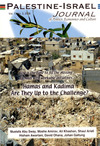The West Bank Wall: Unmaking Palestine by Ray Dolphin. Introduction by Graham Usher. Pluto Press, London & Ann Arbor, 2006, Paperback, 228 pp.
Paul Scham
These two books, even in their titles, epitomize some of the reactions and attitudes towards Israel's vast construction project, meant to "separate" most Israelis and most Palestinians in the name of security and/or expropriating land. It has gone through various political and legal permutations while the most recent developments and changes of attitude, in the wake of the successful penetration of Israeli security by Katyusha rockets during the latest Lebanon war, are too fresh to be covered by either of these books.
Isabel Kershner is a well-regarded and liberal Israeli reporter who has covered the West Bank and Palestinian affairs for the Jerusalem Report magazine for many years. Her book is of the "reporter's notebook" genre; focusing on the human effects of the barrier, with the political context, along with large swathes of recent history.
She tries, and largely succeeds, in fairly representing the security considerations on the Israeli side and the economic and personal cost to the Palestinian side, as well as the international concerns and the considerations that led the Israeli Supreme Court to order a rerouting of significant portions of the fence, though still keeping the largest part, by far, within the West Bank, east of the Green Line. She also deals with the anguish of the settlers, who face losing their homes if and when the project is completed.
Kershner's own views flash out occasionally, as when (on page 132) she refers to an Israeli Arab attorney "shamelessly declaring his intention of exploiting the state institutions which nurtured him in order to delegitimize them." However, she clearly feels for the costs to both sides, and seems to conclude this project is part of the larger dynamic of the continuing struggle, one that cannot and perhaps should not be stopped unless the situation fundamentally changes.
Barrier successfully humanizes the concerns on both sides, from Israeli settlers to Palestinian militants. Kershner successfully weaves together the personal and political, along with appropriate helpings of the legal, without demonizing either side, but with a clear, if muted, Israeli perspective.
Kershner's book leaves one with a strong feeling of the moral and political ambiguities on both sides, with little sense of how they may be changed.
***
Ray Dolphin, by contrast, has no ambivalence or reticence. He considers the wall an unmitigated evil and a continuation of Israeli policies dating back to the early years of the State and even before, designed principally to expropriate Palestinian land and delegitimize Palestinian national aspirations, while making life for Palestinians as difficult as possible. He also provides historical and legal background, but in a format that puts it all in the context of a systematic assault on Palestinians, a conscious avoidance of available peace avenues, and a national purpose of territorial maximalization.
Dolphin's book should not be seen as a piece of propaganda. He has done careful research and understands the Israeli political context. Dolphin focuses primarily on the Palestinian suffering occasioned by the wall, and documents carefully (the book is well-footnoted) the Israeli economic advantages, and effective opportunities for land expropriation that the wall provides. Dolphin believes that massive non-violent resistance, plus international pressure, are the only factors that could change Israel's mind, though he is by no means hopeful of that happening. He sees non-violence as a necessary strategic choice on the Palestinian side, apparently viewing violent attacks, let alone suicide bombings, as counter-productive, since they provide continual (and, to many, credible) excuses for stepping up Israeli attacks on Palestinians.
The stridency of Dolphin's more political and much angrier work is likely to turn off Israeli and Jewish readers, which is unfortunate, as his book presents unpalatable views which are nevertheless sometimes hard to refute, most notably the choice, in almost every instance, to route the barrier through Palestinian land rather than on the Green Line itself.
Of course, the whole fence/wall/barrier enterprise is necessarily called into question by the phenomenon, and apparently comparatively easy availability, of rockets and missiles, although the Olmert government has not yet acknowledged this. Like so much in the conflict, the future of this idea is seriously in doubt, while both sides are coming to terms with what has already been built.
It is particularly sobering that both books were apparently completed less than a year ago, but that was before new governments in Israel and the Palestinian Authority, the rise of Hamas and the fall of Ariel Sharon, let alone the Lebanon War whose effects on the Middle East, as well as on the Israeli-Palestinian conflict, are still being intensively assessed. This almost seems like last year's issue. However, with a half-completed barrier, and walls of distrust ever higher, there is little doubt that the issue will rise again.

